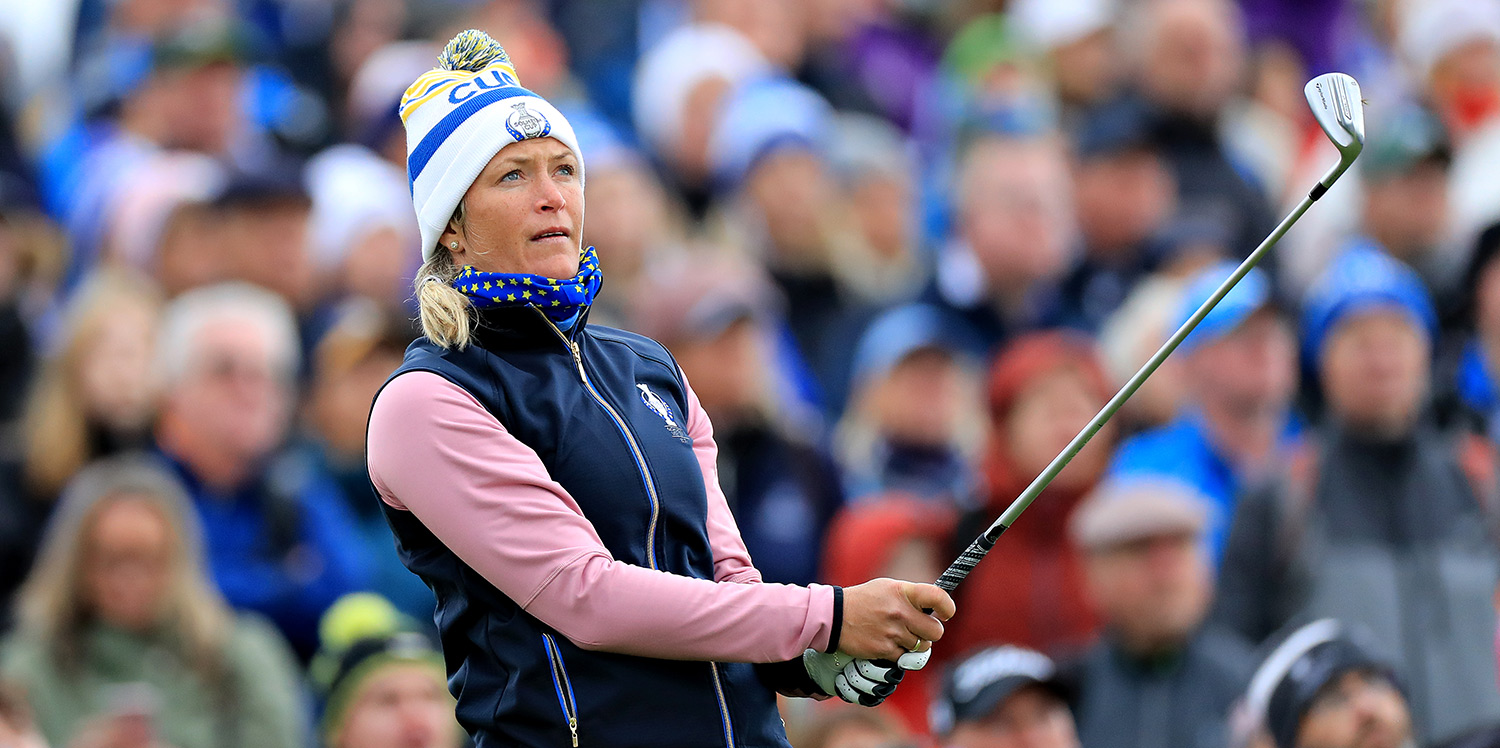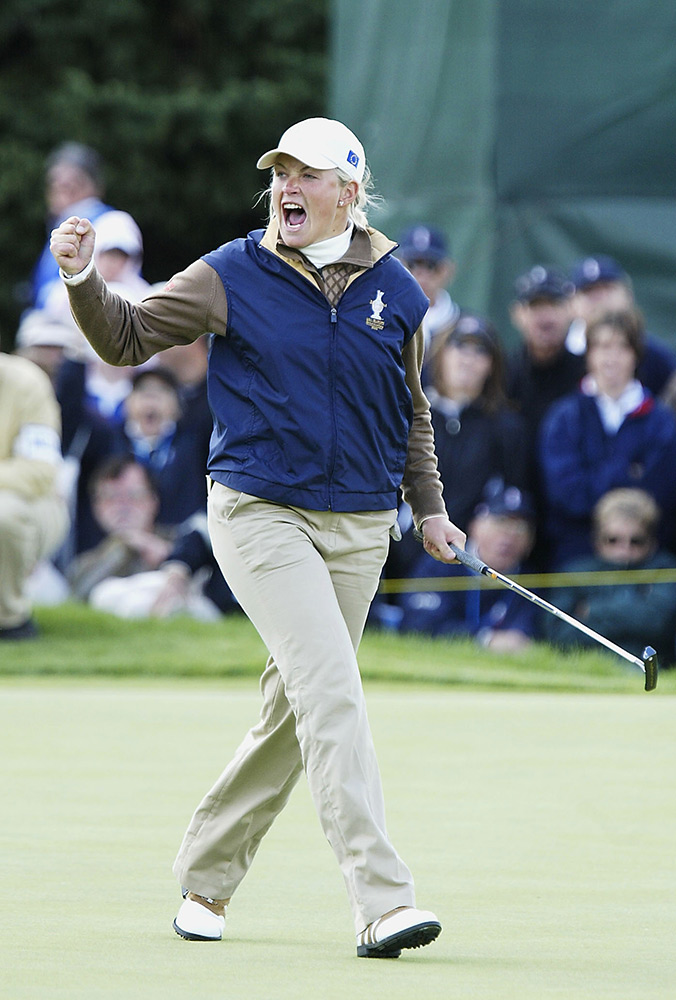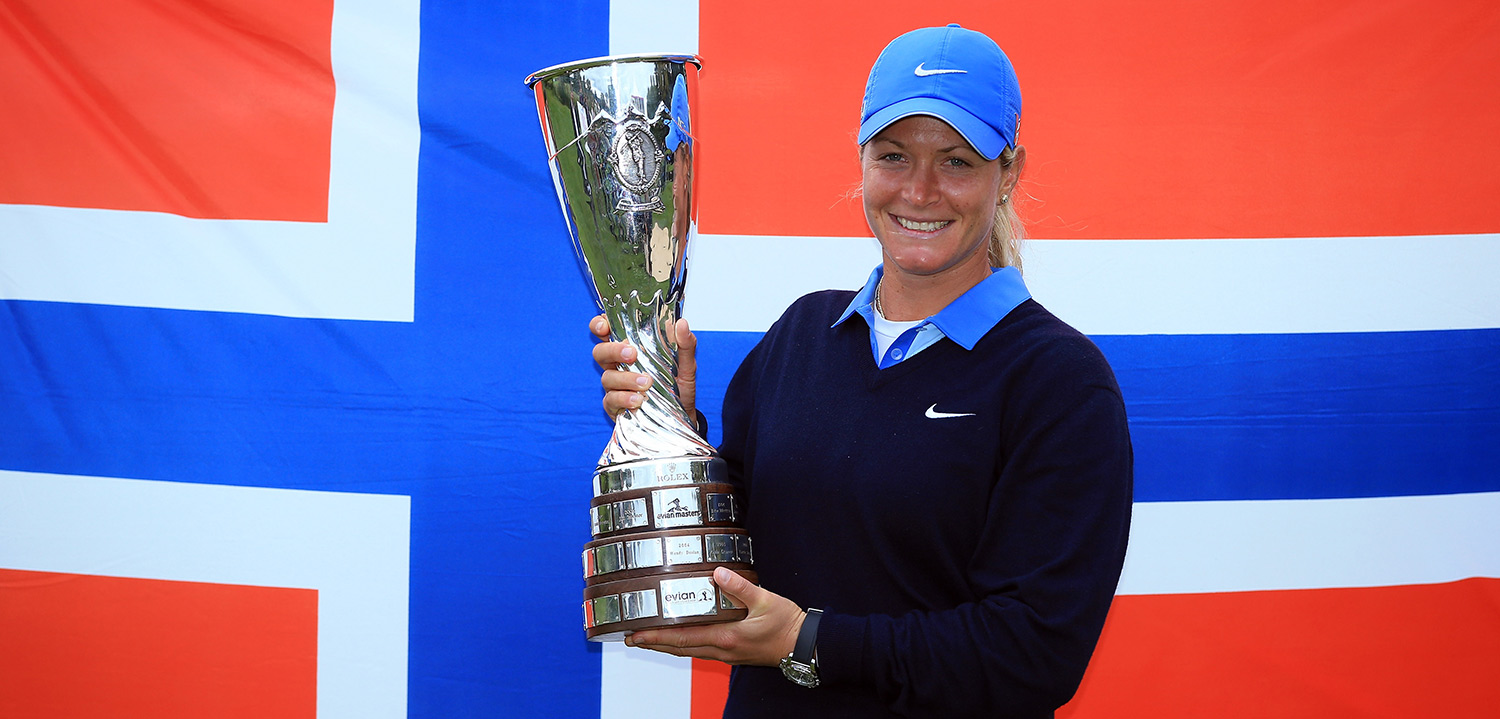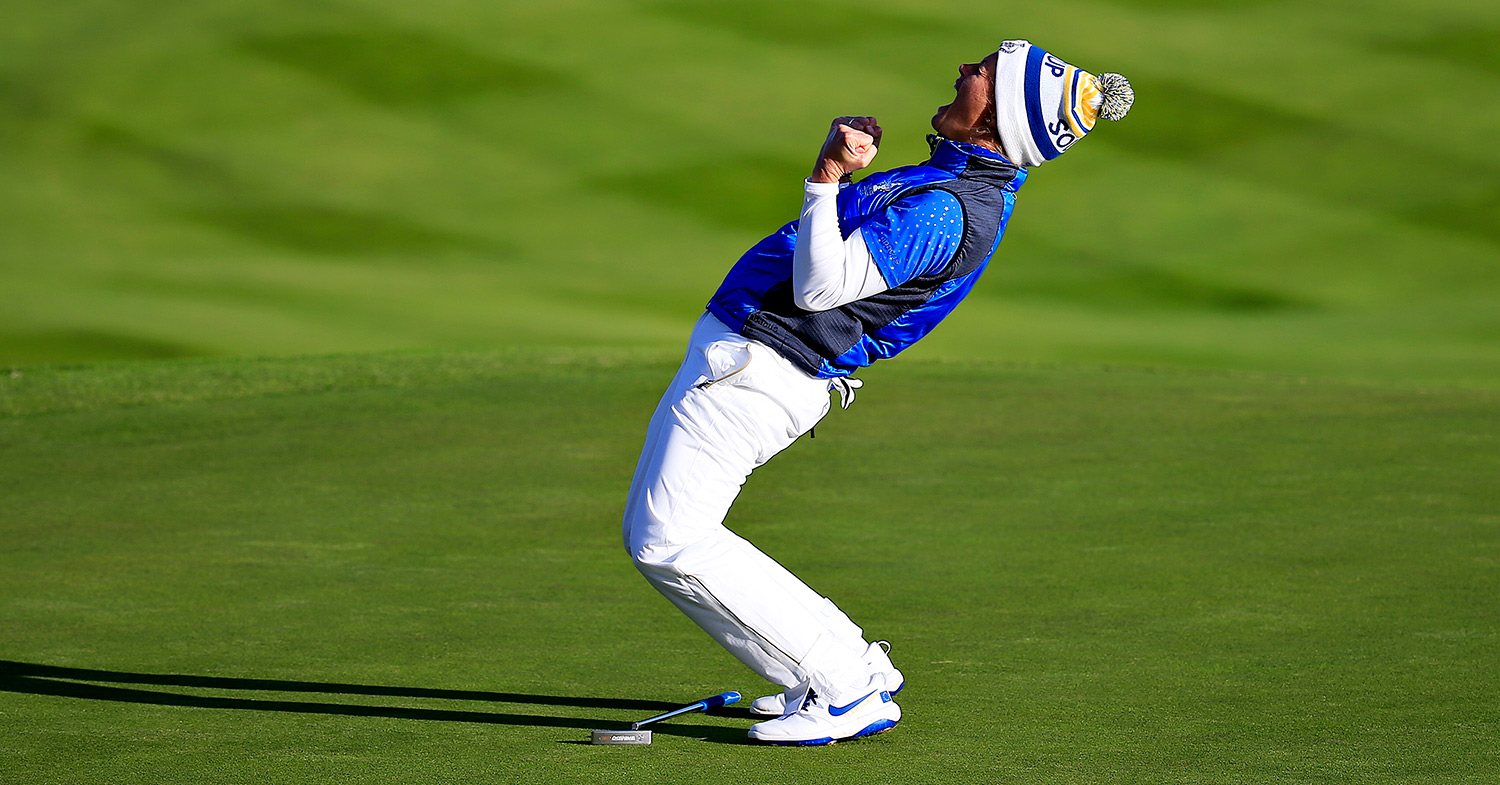
When presented with a perfect moment, Suzann Pettersen did something many others could not do: she seized it. Here, the two-time World No.2 offers her definition of an easy putt and walks Kingdom down a fairway with a fairytale ending
“I see too many men delay their exits with a sickly, slow reluctance to leave the stage,” wrote John Steinbeck in his Travels With Charley. “It’s bad theater as well as bad living.”
Steinbeck would have enjoyed the show at Gleneagles last September, when a European Team led by Catriona Matthew denied Juli Inkster’s Team USA what would have been a Solheim Cup three-peat.
Neither sickly nor slow, the riveting matches came down to the final putt, a perfect moment seemingly scripted for the cinema, which landed squarely on the shoulders of Suzann Pettersen.
To understand how the Norway native delivered on that moment, and why she retired from professional golf an hour later, it helps to consider why she was in Scotland in the first place, 38 years old and coming off 20 months of almost no golf. That sabbatical, around the birth of her son, led to a world ranking of 635th and to some considering her a controversial captain’s pick, but Matthew knew she wasn’t taking any chances with the selection. And 20 months off? Well, everyone’s entitled to a little break after 19 years with no vacation.

“When you’re in the bubble, when you’re in competitive mode, which is literally 24-7,” Pettersen explains, “everything you do, every decision you make, every choice you make, every move you make, is for becoming a better golfer.”
Twice World No.2 with 22 pro wins (15 on the LPGA Tour, including two majors), Pettersen outlined the sacrifices she made in a letter to her young son, Herman, which she penned after announcing her retirement. From the letter:
“I didn’t realize it at the time, but tour life became so intertwined with my personal life that I sometimes could not tell them apart. My identity was linked to my job. How I played, how my practice sessions went on a particular day, how many putts I made or missed—all of that affected my moods, my priorities, my relationships and most of my decisions. I was, to some degree, selfish, which I considered a prerequisite for success. I had no trouble saying ‘No’ and I did it quite a bit when I felt that someone or something was intruding on my time. That was part of the job. And my job, being one of the best golfers in the world, was my focus.”
That focus started almost from the very beginning, Pettersen says, when as a girl growing up in Oslo she found golf.
“I’m the youngest of three,” she says. “My brothers did all kinds of sports and I just kind of followed in their footsteps. It was our dad who introduced us when I was about 5 or 6. Alongside a lot of other sports I started golf and I thought it was a lot of fun—fun enough that I kept putting more time into it.”

By the time she was 10 or 11, she was playing year-round, which in Norway means that she was often playing indoors.
“In winter after school you took a bus to these indoor hitting bay centers we have here in Norway. On a school holiday my family would maybe take us to Southern Europe for a week or so and then it was back to the hitting bay inside. That’s kind of how the years plugged along. The summers are fairly short, and at the time you didn’t know better. I didn’t know that I could have had grass under my feet. You make the best of it, and in fact it’s a good way of practicing.”
Hitting indoors allowed Pettersen to focus on technique, she says, honing her form before taking it outside. The hard work paid off, and though Pettersen admits that the talent pool in Norway was limited compared to some other countries, her success is impressive.
“Not to be cocky, but I kind of dominated the juniors throughout my junior career,” she says in brusque-but-accurate fashion. “Actually, from 13 until 18 I might have lost one tournament that I played. For me that was great because you learn to win, and I think it was an important part of my development, learning to win at every stage and learning to dominate. Obviously I did quite well.”
In addition to tearing through junior tournaments in Norway, Pettersen won the Norwegian Championship five times, taking it every year between 1996 and 2000. Over that time she sharpened her game in neighboring Sweden, where she says the juniors were tougher, rivalries developed, and competitions were more intense. The juniors were also where she experienced team golf for the first time, representing Europe in the Junior Ryder Cup in 1997 and 1999 and playing for Norway in the World Amateur in 1998 and 2000.
At 19 she won the 2000 event in Berlin—“It was the crown on my amateur career”—and quickly turned pro, taking the 2001 French Open en route to being named that year’s Ladies European Tour Rookie of the Year. Three top-10 finishes followed in 2002, the same year in which she qualified for the LPGA Tour with a T-10 at the Tour’s Final Qualifying Tournament.
But 2002 was notable for another reason as well in that it was Pettersen’s first appearance at the Solheim Cup—and it was a tough assignment. Playing against the Americans on American soil (at Interlachen) just a week after the one-year anniversary of the September 11 attacks, the Europeans were under tremendous pressure. A stealth bomber flew over the opening ceremony, flags were flying high, and the Americans, led by Patty Sheehan, were on a mission to regain the cup they’d lost at Loch Lomond in 2000. Pettersen made an instant statement, coming from five holes down in the fifth singles match to tie Michele Redman and keep the U.S. from taking the lead—and then she energetically discussed the comeback with some adrenalin-fueled colorful language in a live NBC interview, instantly underlining her commanding performance on course and winning younger fans in Norway as well.
It was the first of nine Solheim appearances for Pettersen, and it set the tone for her successful non-stop career. Non-stop until 2018, anyway.
In January 2018, pregnant with Herman, Pettersen was in Orlando (where she’s lived for roughly 20 years) preparing for the LPGA’s Asia swing. Concerned with complications she was experiencing, she was admitted to Arnold Palmer Hospital—where she checked out fine.
Still, for reassurance she flew to see her doctor in Oslo who, while confirming she was okay, also told her she was grounded. As Pettersen explains in her letter to Herman:
“My brain didn’t process that. I said, ‘I’m supposed to leave for Thailand tomorrow.’ The doctor replied, ‘There’s no reason to take the risk.’ So, I did some quick calculating and said, ‘Okay, I’ll stay here until the Tour comes back to Arizona for the Founders Cup and rejoin them there.’ He said, ‘Are you not hearing me? You can’t fly. Not to Thailand, not to Arizona, not to England: you’re grounded.’ I was stranded in Oslo, which, in hindsight, was the greatest thing that could have happened to me.

“I’ve been injured several times over my career,” says Pettersen. “But even when I was out with a ruptured back, your brain switches from ‘competitive mode’ to ‘rehab mode’, so then all of your focus and determination is on that: how you can do the rehab as good as possible, as fast as possible. You always find the edge in your brain to stay on track as an athlete.
“When I was grounded in Oslo I thought to myself, ‘What’s the point?’ Yeah, I could have practiced, been grinding on my swing, worked on my technique here in Norway, but why? You’re not going to compete this year, and I just decided that if I’m not going to compete I’m going to give myself a break.”
For a woman who’d practiced year-round, day in and day out for most of her life, this was more difficult than it sounds.
“I felt stressed, I felt guilty; I’d always been grinding to find answers, to find solutions, and now…? I had dinner with my mom and dad and my husband [Christian Ringvold]. The four of us came to the conclusion, just take the year off, enjoy this chapter, you don’t know what it will bring. And at the time I took the decision it was a massive relief. I didn’t feel bad about it, never second-guessed it. I didn’t think about golf, which was a little bit weird.”
For the first time ever, Pettersen checked out of the game and focused on life off course. In August of 2018 Herman was born, a vibrant beautiful kid, and Pettersen says she was instantly smitten—so much so that golf still wasn’t on her mind, even after eight months of not playing.
“During the last part of the pregnancy and the first couple of months after giving birth, I had no desire to push to come back, to rush to come back. People say after you have a child maybe the brain changes, the body changes, that a lot of mothers become better than they were before, and these questions… You almost wanted to see the answer, but at the same time my heart didn’t say ‘go for it.’”
And so she didn’t. Not until spring, when she picked up a golf club for the first time in over a year. The Solheim Cup was six months away.
As Dow is one of her longtime sponsors, Pettersen had committed to the Dow Great Lakes Bay Invitational in mid July, and she says she wanted to show up for the event.
“I wasn’t going to be unprepared, I didn’t want to make a fool of myself. It wasn’t before March, April came along that I thought ‘You need to get your act together, find your golf clubs again, dust the rust off.’”
During a rust-dusting round with friends, Solheim came up.
“They were pushing, saying ‘come on, practice, we need you on the team!’ I was like, ‘No you don’t! There are 12 others who would do a great job. Quit pushing me. If my heart doesn’t say “Do it” it’s not going to matter.’”
But then on August 12th Matthew announced her as a captain’s pick, and everything changed. There wasn’t much time, but Pettersen entered two events in addition to the Dow, ultimately missing the cut in both but gaining much-needed time on course, she says. “I had six competitive rounds, six more than I thought I would have had.”
Eyebrows raised when she was announced, and the word “controversial” showed up more than a few times in golf media, but Pettersen wasn’t having any of it.

“At the time we didn’t have too many obvious picks, but if some of these players had played their hearts out, delivered, played their way onto the team, I definitely would have considered if I was going to take a spot away from a player who deserved a pick. But too many players weren’t delivering when it mattered the most.”
As important as how one is playing, Pettersen says, is what a player can bring to her team, and with eight Solheims under her belt at the time, Pettersen brought a lot of experience, which turned out to be critical.
“Having been there before,” she says, “knowing what it could come down to, it almost makes it easier.”
Easier for her perhaps, but no less thrilling to watch. Coming down the stretch on the last day against American Marina Alex in the final match still in play, and with everything on the line, Alex hit her shot above the hole while Pettersen wedged to roughly 8 feet below. Alex missed hers, and suddenly all eyes were on Pettersen. Her 2015 Solheim had ended with a tough loss and controversy. She’d been forced to withdraw from the 2017 event with a back problem. She’d been away from the game for nearly two years, and now this.
“I was more nervous on the wedge shot; you don’t have to be much off line before that ball is off the green,” she says. “The putt, it was an easy putt, as easy as it could possibly be: left center, almost right on the fall line. As soon as the ball left the blade I knew I’d hit it perfectly on line. If you were to give yourself one putt that mattered the most…”
The putt dropped and mayhem ensued as the Europeans stormed the green and a radiant Pettersen celebrated with her teammates. Watching the replay, as the win starts to sink in and a happy calm starts to settle on the crowd, Pettersen appears with Herman in her arms, the sun shining on the new family. In an hour or so she’ll surprise the golf world by announcing her retirement, but to anyone who has known her over the past 20 months, the surprise likely already had given way to understanding.
“I mean, it’s priorities,” Pettersen says. “There’s a time for everything in life, and it was quite a good time to step away.”
Follow Us On


| Cookie | Duration | Description |
|---|---|---|
| cookielawinfo-checkbox-analytics | 11 months | This cookie is set by GDPR Cookie Consent plugin. The cookie is used to store the user consent for the cookies in the category "Analytics". |
| cookielawinfo-checkbox-functional | 11 months | The cookie is set by GDPR cookie consent to record the user consent for the cookies in the category "Functional". |
| cookielawinfo-checkbox-necessary | 11 months | This cookie is set by GDPR Cookie Consent plugin. The cookies is used to store the user consent for the cookies in the category "Necessary". |
| cookielawinfo-checkbox-others | 11 months | This cookie is set by GDPR Cookie Consent plugin. The cookie is used to store the user consent for the cookies in the category "Other. |
| cookielawinfo-checkbox-performance | 11 months | This cookie is set by GDPR Cookie Consent plugin. The cookie is used to store the user consent for the cookies in the category "Performance". |
| viewed_cookie_policy | 11 months | The cookie is set by the GDPR Cookie Consent plugin and is used to store whether or not user has consented to the use of cookies. It does not store any personal data. |